
When we begin the process of identifying an unknown plant, we are like detectives looking for clues in any places we can find them.
The more clues we can find, the stronger our case is of matching the plant we see to its correct scientific name. Once we have this information, we have everything we need to do some background research on whether the plant is native or introduced, weed or ornamental, and endless other information.
Flowers: The Crowning Achievement Of Plants
Flowering plants, or angiosperms, are the largest group of plants that we work with as gardeners and make up most of our veggies, fruits, herbs, flowers and ornamentals.
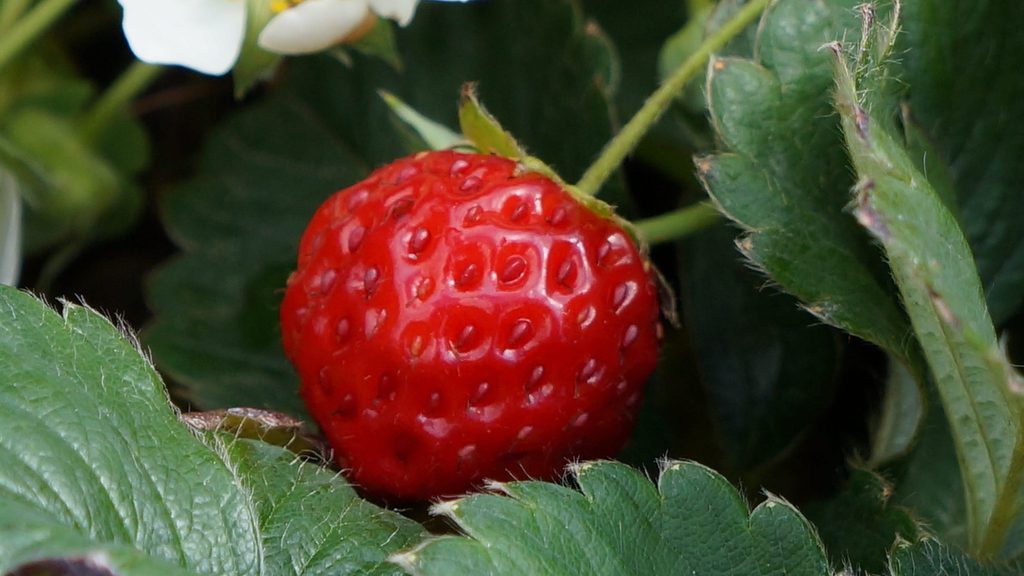
Strawberries Fragaria × ananassa are a rose family member with a very interesting fruit. Image source
Before flowers evolved, plants such as conifers and ferns would expend massive amounts of energy creating spores and pollen that would be carried by the wind or water to germinate and create seeds that would give birth to new plants.
This was a pretty wasteful and inefficient way to reproduce because only a tiny fraction of spores or pollen were successful; most never really achieved anything. Then along came a new adaptation which recruited pollinators to help them carry pollen to the female parts of the reproductive system.
Suddenly these new flowering plants were getting a much higher success rate for the energy they were putting into creating pollen and quickly began outcompeting almost all other plants. As a result, only a fraction of the number of conifers and ferns were able to compete and stay relevant within the ecosystem until today.
Over time flowers became more attractive to a wider variety of pollinators using a variety of tools at their disposal: bright petals that stood out like neon diner signs, beautiful or ugly scents to attract pollinators, as well as changing size and shape to become more hospitable to specific pollinators.
Flowering plants can be broken into two groups: monocots and dicots. Monocots include grasses, palms, and alliums whereas dicots include plants such as legumes, roses, and mint family herbs.
What Are Flowers?
The flower is an organ, or system of multiple organs, that is responsible for sexual reproduction in angiosperms. Flowering plants use both male and female organs to create brand new genetic material that has never before been seen on earth just like each human with their individual fingerprint.
Flowers have a vegetative part and a reproductive part. Included in the vegetative part are the sepals and petals whereas the reproductive part includes male and/or female parts.
Once the pollen (male) has been received within the ovum (female), one or more seeds are created within a casing called a “fruit”, whether that’s a fleshy fruit, a bean pod, or a single dandelion “achene”.

A dandelion Taraxacum sp. of the aster family’s seed head with achenes. Each seed is contained within an individual fruit which corresponds to a separate flower within the inflorescence. The helicopter wings are the true fused sepals. Image source
The fruit can serve many purposes to help the seed begin a new plant, from providing nourishment for the seedlings to providing an incentive for animals to eat and spread the seeds while giving them a nice manure boost.
Only a small fraction of seeds released will ever make it to being a new plant, though some species are generally more successful than others.
The Different Parts Of A Flower
In order to identify plants using flowers, we need to understand the different parts that make up all flowers. The same basic parts have evolved to look vastly different within plants and we use these differences to differentiate between which plants are closely related.
Sometimes a plant will discard a flower part. Grasses do not have petals or sepals due to the fact they’re wind-pollinated and have no use for a bright attractant to insects or other pollinators. This doesn’t present a problem when trying to identify the family; in fact, it helps make a positive I.D.
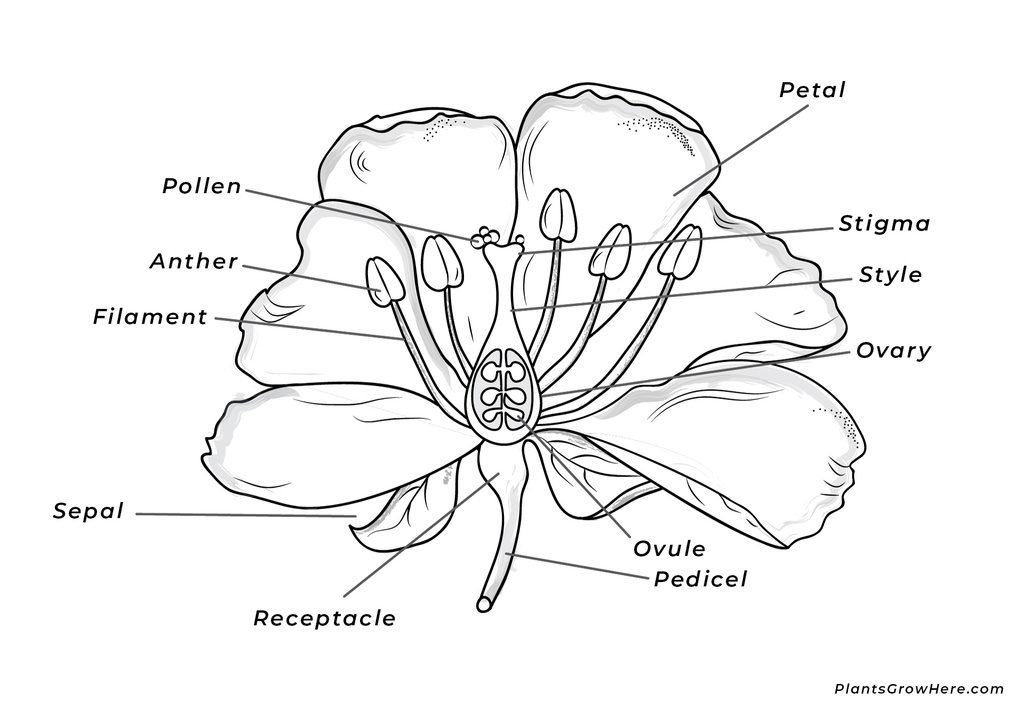
A diagram of the basic flower parts, via Plants Grow Here.
Vegetative Parts (Perianth)
-The calyx, individually called the sepals, are situated on the outside of the petals but usually less conspicuous. Exceptionally in some plants, the sepals are more pronounced or contrast in interesting ways with the petals. Other flowers, like lilies, have sepals that are almost indistinguishable from the petals until you look more closely.
-The corolla, individually called petals, are usually the visual highlight of the flower. Often serving as a sign to attract pollinators, they can be brightly coloured or shaped in peculiar ways.
-The receptacle is the connection upon the peduncle that connects to the flower. The fleshy part of a strawberry is actually the receptacle for tiny fruits on the surface, and a fig is another receptacle that is hollow with the true flowers and fruits growing on the inside.
-The peduncle is the stem that intersects between the flower, via the receptacle, and the mother branch.
Reproductive Parts (Androecium & Gynoecium)
–Androecium, stamina or stamens is the collective term for the male reproductive part, the stamen. This organ type produces pollen to fertilise seeds inside the ovary.
Pollen is created and housed inside of microsporangia, or pollen sacs. There are typically 4 pollen sacs in an anther lobe, which is housed on the filament. The part of the filament where the anthers attach is called the connective.
–Gynoecium is the collective term for the individual female reproductive part, the pistil.
The stigma is at the very tip and is the gateway to the ovule. It’s often covered in a waxy or slimy substance as well as tiny hairs to trap pollen. You can see the pollen stuck to the stigma in the diagram above.
The style is the tube housing the pollen tubes that bring the pollen from the stigma into the ovary.
The ovary is the home of the ovules. The ovary becomes the fruit, and the ovules become the seeds.
Work From The Outside In
When we describe a flower, we start with the outermost layer (sepals and petals) and finish with the innermost layer (the sexual organs).
This helps to avoid damaging the outer layers before we’ve had a chance to study them up close.
Maturity Matters
Flowers will change over time as they mature and die or go to fruit.
It’s important to keep this in mind when we’re identifying plants and it can be beneficial to study the flowers at different stages, from bud to fruit.
Study Multiple Flowers
In an ideal scenario, you’re going to have a plant that has loads of flowers and won’t miss you mutilating a few. However, sometimes you might want to examine without damaging them if there are few available or you’re in an ecologically sensitive area or somewhere you’re not allowed to damage the flora.
Watch for dud flowers: if there’s a defect or you’ve knocked a petal or stamen off the only flower you’ve studied, you’re going to have a hard time finding a positive identification.
Conversely, if you’ve studied multiple flowers you’re going to have a broader picture of what’s normal.
Who knows, you might even find that what you thought was one plant is, in fact, multiple plants that are growing amongst each other to give the appearance of a single plant.
Use A Hand Lens Or Magnifying Glass
Some flowers are relatively easy to see with the naked eye, such as your average lily. However, if you want to look at a smaller flower such as a plantain inflorescence, you might do well to keep a small hand lens or magnifying glass on hand.
Hand lenses are the tool of choice for most horticulturalists because they’re compact enough to fit in your pocket.
Flower Sex
Flowers can have one sex or two.
Bisexual flowers contain both sets of sexual organs. This means you’ll see pistils and stamens on the same flower on a single plant.
Monoecious plants have separate male and female flowers on the same plant. The classic example is members of the squash family, where female flowers have a baby fruit, or ovary at the bottom whereas male flowers do not. Aroid inflorescences are monoecious as well.
Dioecious plants only have one sex, so there are separate male plants and female plants. Hops in the hemp family Cannabaceae and used in beer brewing are such an example: the flowers of the female plant are what is actually used, and male plants are only useful for reproduction so usually are eradicated. Certain palm species such as dates are also dioecious.
Flower Symmetry
Look at a flower face-on. It’s going to be symmetrical along at least one line, possibly multiple lines.
If it can be divided into equal parts along more than one line, the flower is called a regular flower.
If it can only be divided along one line, it’s an irregular flower.
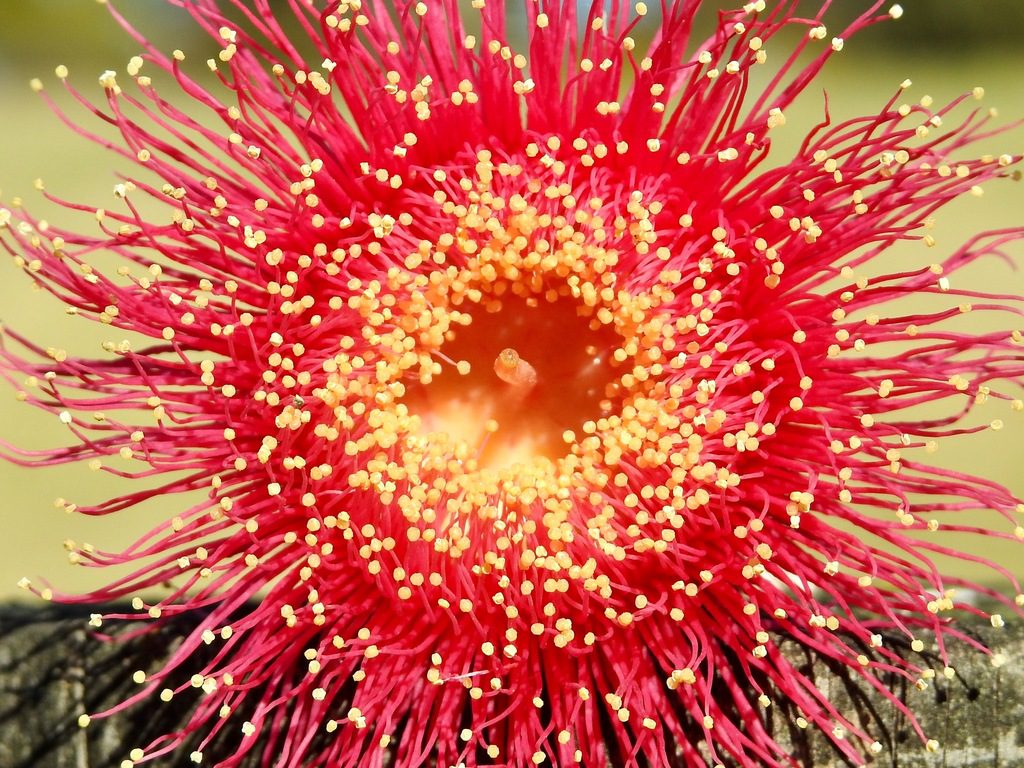
A Eucalyptus sp. flower which is radially symmetrical, or regular, with whorls of fuzzy stamina surrounding a single pistil. Image source
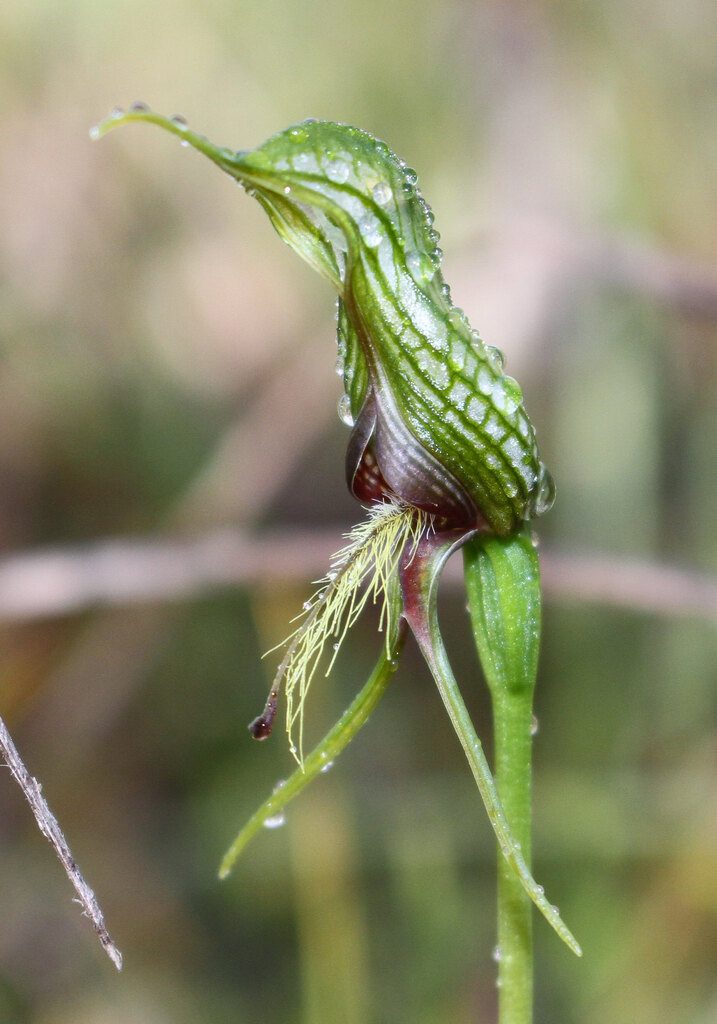
A bird orchid Pterostylis barbata with a flower that is symmetrical down the middle, but not radially, so is termed irregular. Image source
Inflorescences
Angiosperms may have a single flower a stalk. Or, they may have an inflorescence, which is a group of flowers that are attached to a single stalk.
We call the stalks that individual flowers are attached to a pedicel and the common stalk that each flower’s pedicel in an inflorescence is called a peduncle.
What we call a protea flower may seem on the surface to be a normal flower, but in fact, is an inflorescence made of countless tiny true flowers arranged around a peduncle. Believe it or not, members of the aster family such as daisies and sunflowers are also inflorescences made of countless tiny flowers.
When an inflorescence looks like a single flower, as in the case with proteas and asters, we can term the inflorescence a compound flower, more specifically a capitulum or head. There are often petal-or-sepal-like “bracts” around the flower head which are modified true leaves.
Pedicels On Inflorescences
Sometimes flowers within an inflorescence will each have a pedicel, and sometimes the flower will attach straight to the peduncle.
Examples inflorescence types with pedicels, called pedicel inflorescences, are raceme, panicle, corymb and umbel types.
Examples of inflorescence types without pedicels, called sessile inflorescences, are spikes, capitula, catkins and spadices.
The Two Types Of Inflorescence
There are two main types of inflorescences: racemose and cymose.
The difference between the two is based on what happens at the growing tip: if the tip of the growth ends with a flower, it’s a close flower whereas of the branch keeps growing with flowers coming off laterally (on the sides), it’s a racemose inflorescence.
On a racemose inflorescence, called a raceme, the newest flowers are at the tip of growth and old flowers are to be found further back along the peduncle.
A spike is a (usually erect) raceme with sessile flowers. A catkin is a (usually tightly compact) spike that hangs down instead of standing erect. A compound raceme, also called a panicle is a branched raceme.
On a cymose inflorescence, called a cyme, the oldest flower is at the tip and newer flowers form beneath during growth.
A monochasial cyme has a single peduncle without branching, whereas a heliod or panicle-like cyme is branching.
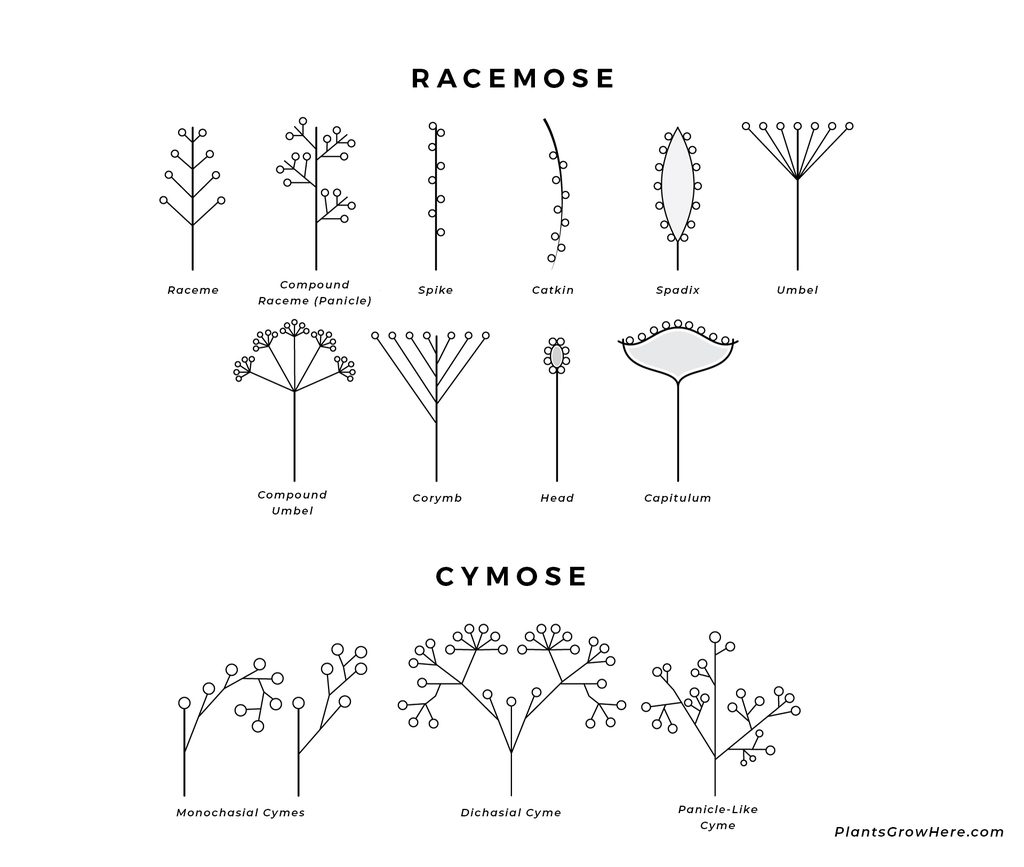
A diagram symbolising different racemose and cymose inflorescence types via Plants Grow Here
Leaves
Leaves come in all sorts of shapes and sizes but consist of the following parts:
Stem: The branch or stem is where the leaf emerges from, specifically from a node.
Petiole: The stem that attaches the leaf to the branch is called a petiole, and when this isn’t present a leaf is said to be sessile.
Stipule: The leaf may or may not show stipules, which are little winglets on the sides at the base.
Lamina: The actual leaf “blade” is called the lamina and exists around the veins.
Veins: Used to transport water and sugars to and from the leaf, veins can be a useful tool in identification.
Axil: The nook just above the petiole-stem connection.
Axillary Bud: Nestled within the axil is a new bud waiting to sprout and become a new lateral branch.
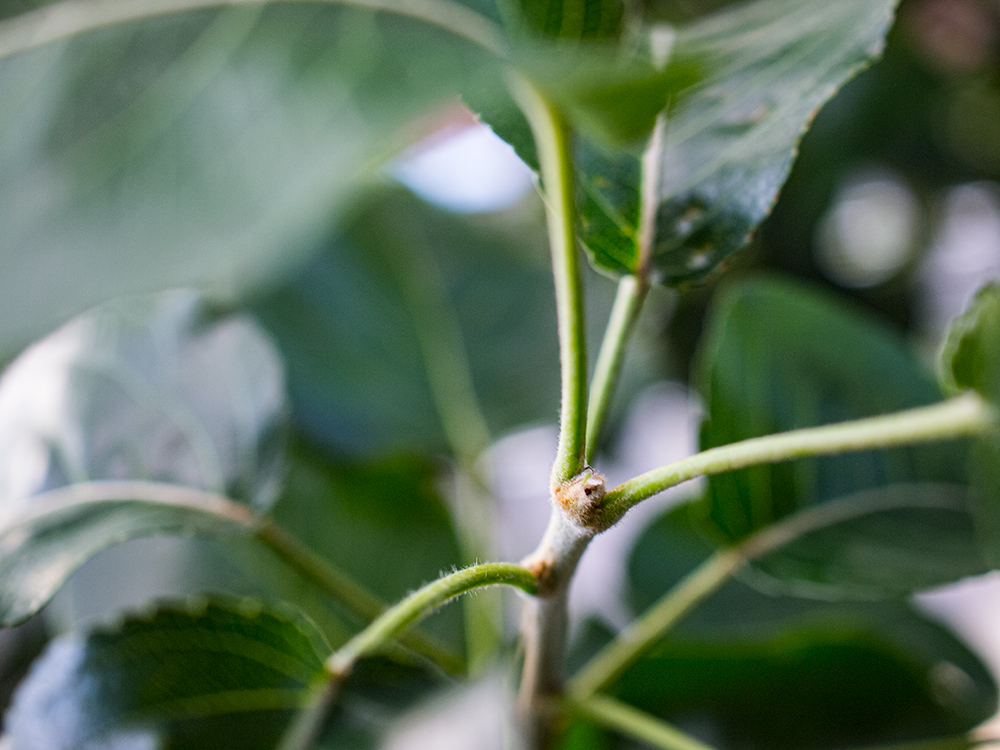
An ornamental pear stem with the apical bud at the terminal tip, an axillary bud nestled into the petiole leaf connection below. You can see the leaf lamina, or blade, as well as the leaf veins. No stipules are seen, however their Rosaceae family relatives true roses do have stipules. Image via Plants Grow Here.
Describing Leaves
We can describe our observations of a leaf using as many of the following as possible.
Leaves come in a variety of different shapes. This refers to the overall shape of the leaf.

A basic leaf shape diagram via Plants Grow Here.
Around the border of the leaf is referred to as the margin. This is to do with the properties of the border itself, instead of the overall shape.
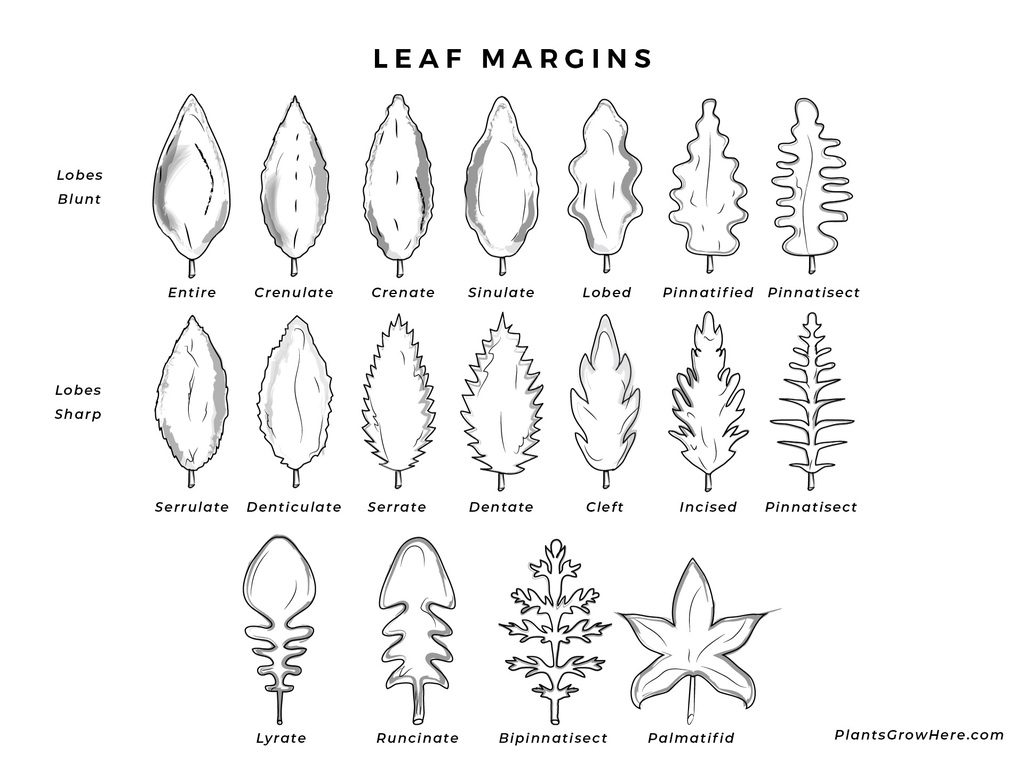
A basic leaf margin diagram. Some margins are hard to show without zooming in. Dentate margins are evenly sharp, and serrate margins have teeth that face forward. Serrulate and denticulate margins are smaller again. Crenate margins have round teeth, and sinulate leaves are wavy. Via Plants Grow Here
We can see differences between plants also in the veins, or venation, on the leaf. Monocots tend to have parallel leaf veins, whereas dicots tend to have reticulate, or branching venation. There are many types of reticulate venation, from simple branches to intricate net-like patterns.
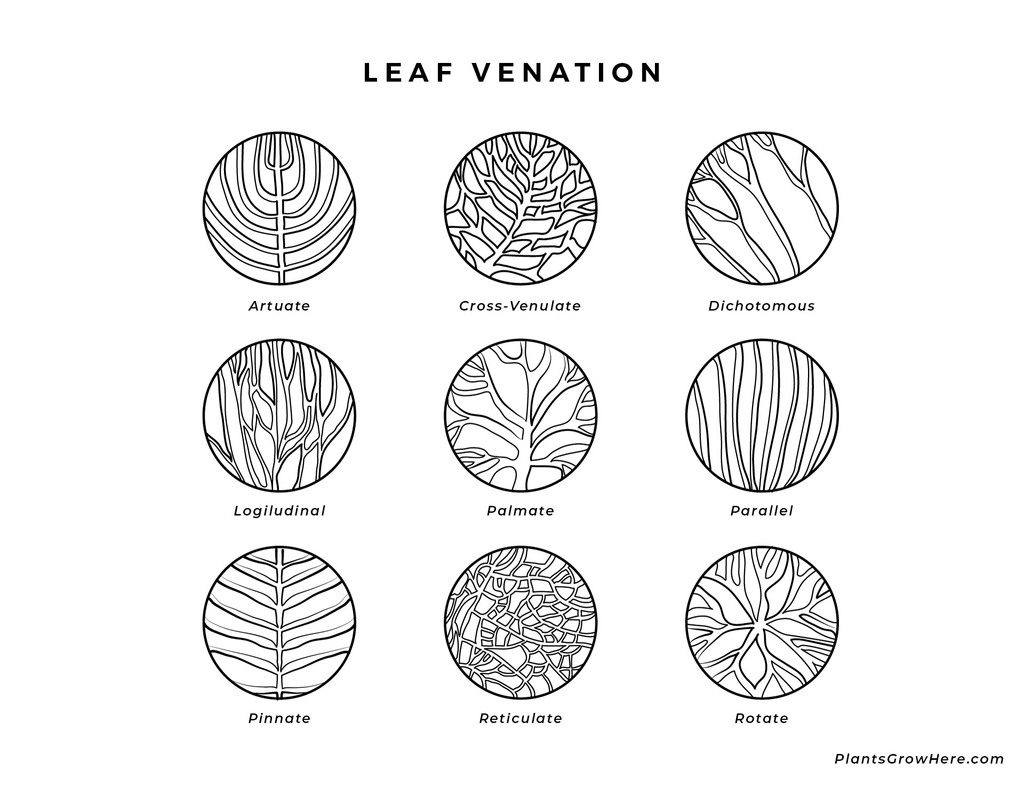
A basic diagram symbolising different leaf vein patterns via Plants Grow Here.
Leaves can be attached to the stem differently between species. They can be termed sessile or pedunculate depending on whether or not they have petiole, just like flowers with their pedicels. They may be decurrent , sheathed or perfoliate as well.

Apices and bases can be described separately to the overall shape and can help build a higher-resolution description of the leaf.
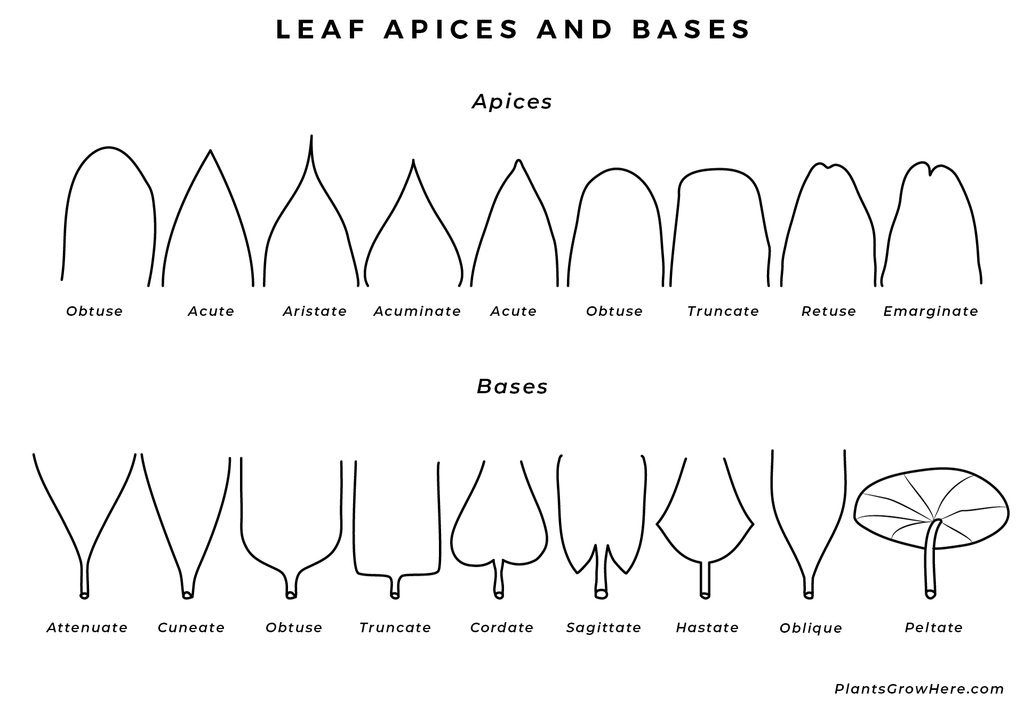
Leaf apex and base diagram via Plants Grow Here.
The feel and texture of the leaf surface can also be vastly different between leaves. Monstera leaves feel almost leathery, whereas hibiscus leaves feel “mucilaginous”, meaning a little bit gelatinous or mucus-like.
The leaf size may help make a positive identification, however keep in mind that plants can sometimes make leaves that are smaller or larger depending on the conditions.
If the leaf is not lobed, serrated or compound it is termed entire.
Types Of Leaves
Leaves are either compound or simple.
Simple leaves are as they appear: a single leaf attached to a stem with or without a petiole. They may have an interesting shape or a complicated venation pattern but they’re still technically a simple leaf.
What classifies a leaf as compound is that there are multiple “leaflets” that are part of a single leaf. Compound leaves are usually easily mistaken as being multiple leaves.
Trifolate compound leaves are compound leaves with three leaflets on the end of the petiole. Think of clover or oxalis.
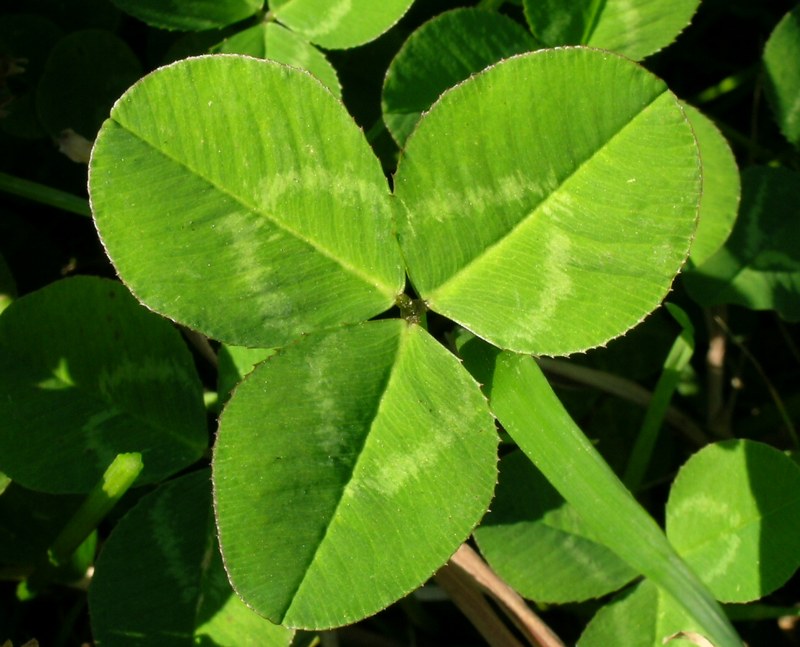
Legume family member white clover Trifolium repens trifoliately compound leaf. Image source
Pinnate compound leaves resemble feathers, in that they have leaflets coming off either side of a vein. They can either be odd-pinnate, where there’s a single leaf at the terminal tip of the leaflet, or even-pinnate where there are an even amount of leaflets along the midvein.
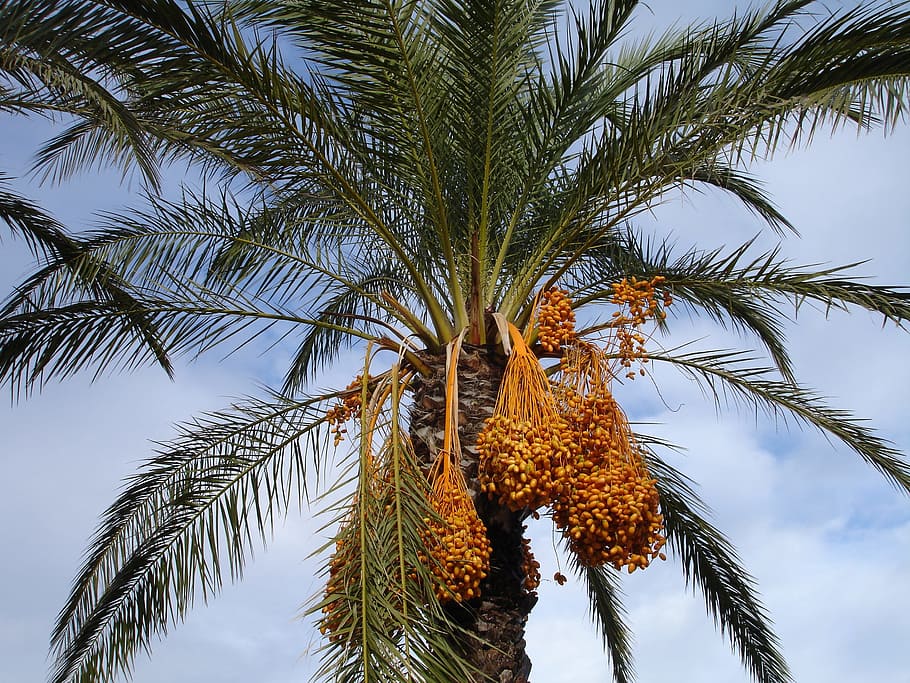
A female date palm Phoenix dactylifera showing pinnate compound leaves. Image source
Palmate compound leaves resemble a hand with multiple fingers. Think about a maple leaf where each of the “fingers” are separated as leaflets instead of connected together.
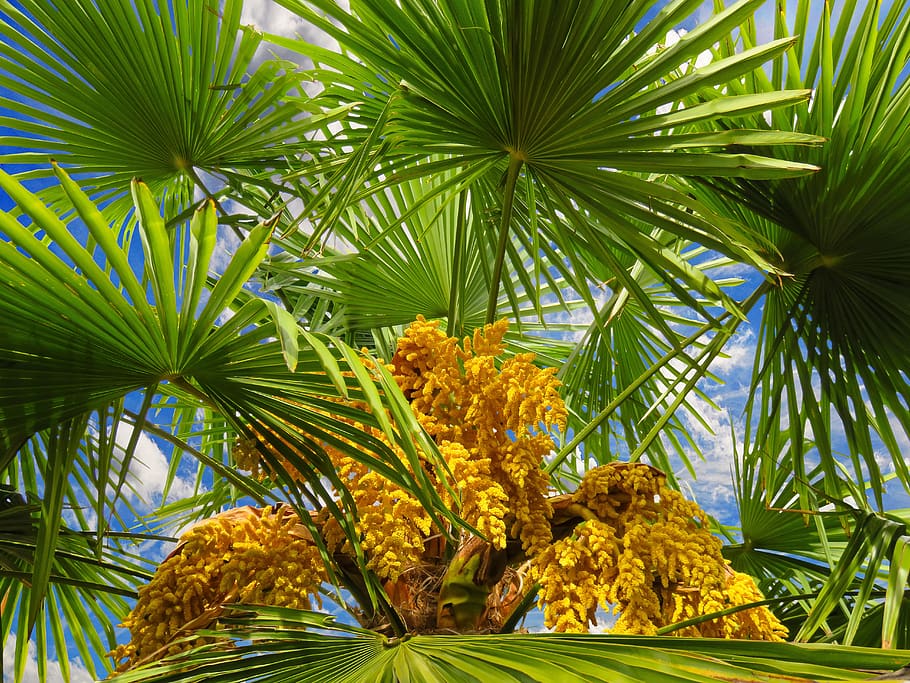
An unknown palm tree with palmately compound leaves. Image source
Compound leaves can even be doubly or triply compound. A bipinnate compound leaf is one with secondary veins where leaflets are situated, and a tripinnate compound leaf is one where the secondary veins branch out into a third level of pinnate leaf structures.
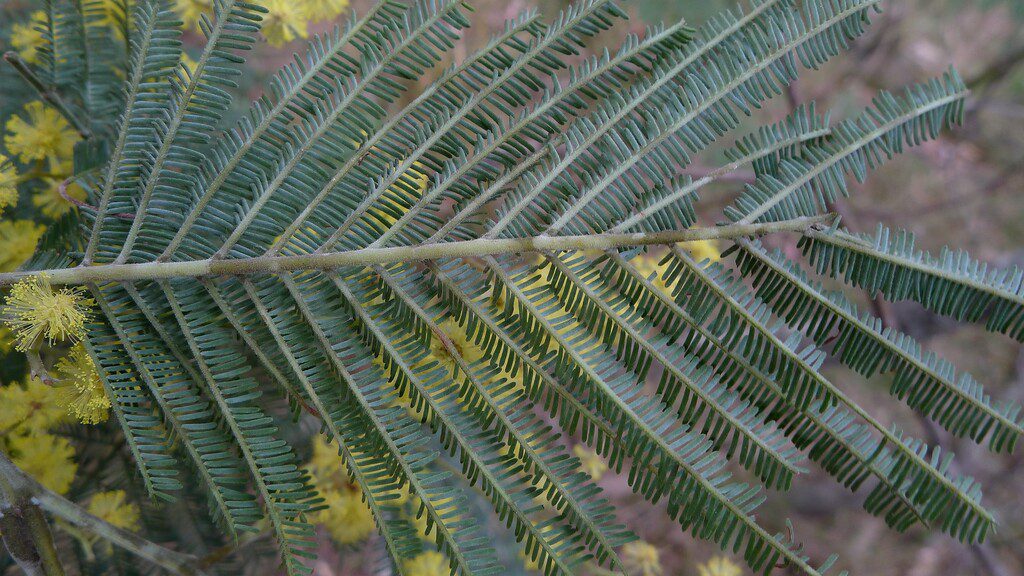
A single bipinnate compound leaf from a silver Wattle Acacia dealbata viewed from beneath, with countless tiny leaflets. Also notice the tiny flower heads each made up of multiple individual flowers. Image source
Arrangement
If the leaves or leaflets are alternately spaced along the branch or vein, rather than being opposite one another, we call them alternate.
If the leaves or leaflets are opposite, we call them opposite. Opposite simple leaves come from the same node.
When more than two leaves come from the same node, we call them whorled.
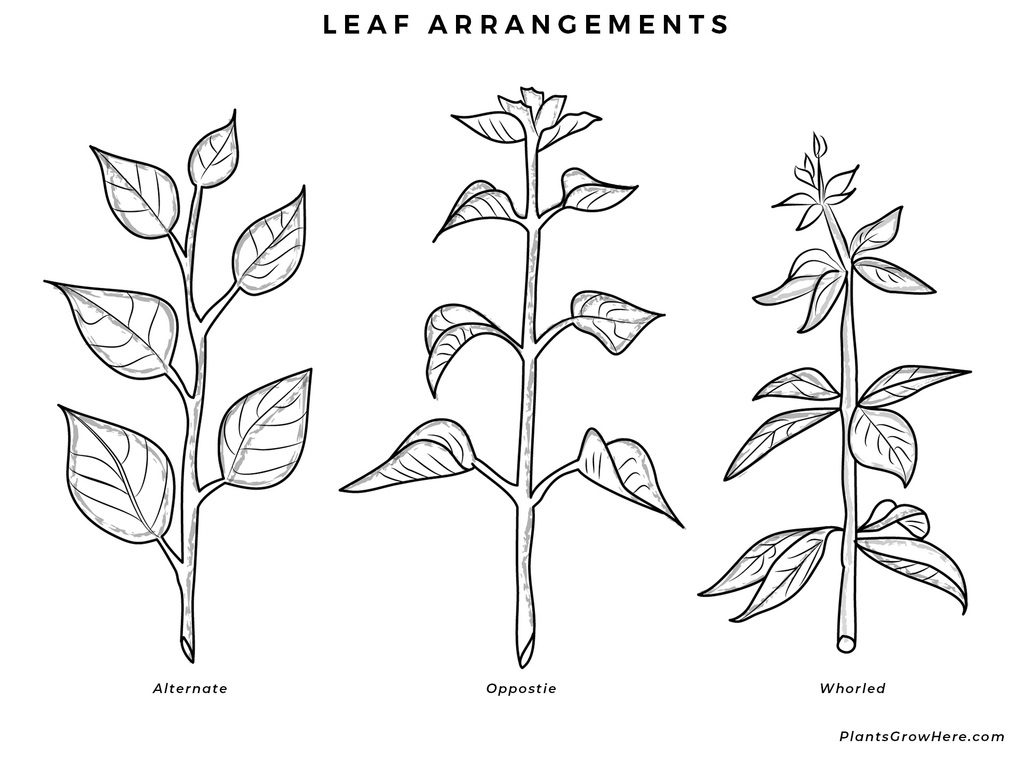
A basic leaf arrangement diagram via Plants Grow Here.
Juvenile vs. Mature
Some leaves look and feel different based on their age; for example, the fresh new spring leaves of a lilly pilly may be red and tender and as the leaf ages it will become dark green.
Not only can the age of the leaf affect how the plant looks, but sometimes the maturity of the plant itself can affect the foliar appearance.
Certain species of eucalypt have round leaves when they’re young and then begin producing narrow leaves after the plant matures a bit.
The shape of each leaf does not change in this case, but the type of leaf a young plant produces is different from the type an older plant produces.
Colour
As mentioned above, the colour can also change between juvenile and mature leaves.
Variegation is when there are pigment changes within the leaf, stem, flower or fruit, and is often a desirable mutation for ornamental plants.
Leaf colour can change depending on the season. Deciduous leaves turn yellow, orange, red or purple in autumn, and tender spring growth can also take on a different colour than mature leaves.
In some cases, leaf colour can help make the distinction between different species and varieties when identifying plants.
Seeds
Every type of flowering (and cone-bearing) plant has its own particular seed that it grows.
There may be many seeds within a pod or fruit, or there may only be a single seed. They can be large, like a coconut, or tiny like the seeds of orchids that are often the size of dust particles.
Habit
The habit is the way a plant tends to grow.
A passionfruit vine’s habit is to vigorously climb using tendrils that slowly turn in search for a grip.
A dandelion’s habit is to grow as a small herbaceous perennial weed (yes, perennial – the roots live on for multiple years) with irregularly lobed leaves forming a rosette, flower heads that are attached to a relatively long pedicel, and a single taproot reaching down into the ground.
Plant habit is a tricky identification clue because two people might describe the same plant’s habit using vastly differing word choices, and it might grow differently in separate circumstances.
This is not like counting the petals on a flower, where the number present will be exactly the same for all plants within the same species (except for the occasional damaged specimen or genetic defect, which can be totally normal).
Roots
You might not think to look at the roots, but they can tell you some things about the plant when it comes to making a plant identification. Dicots start life with and sometimes retain a taproot, whereas monocots always have a fibrous root system.
Plants in the ficus family can have pronounced buttressing and aerial roots, the presence of which may help make the differentiation between other lookalikes such as lilly pillies or privets when flowers or fruit aren’t present.
Stems
Stems can also give clues. How is the habit of the plant; is it sprawled across the floor or reaching for the sky? Are nodes close together or far apart?
Do the stems form a tree, shrub, herb, or perhaps a vine? Are they square or round?
Bark
Bark is a non-technical term to describe the outer layer or epidermis of a plant. It may or may be made up of phloem tissue. Sometimes the bark can be removed without damaging the plant, and sometimes it cannot.
Feel the bark and look at it up close. What does it look like? Does it feel rough or smooth? What does the colour look like? Does it naturally peel off like many members of the myrtle family such as eucalypts do?
Rookie Errors
It can be easy to misidentify plant parts; for example, to mistake a sepal for a petal or a stigma for a stamen. Look closely at the different layers.
Using damaged flowers and leaves is another easy mistake to make as mentioned above, which is why it’s a good idea to check multiple specimens when possible.
Cultivars, which are cultivated varieties that humans have bred with a specific purpose (such as fleshy fruit or colourful blooms), can mess with our identifications as well.
The rose family usually has flowers with 5 petals, but many roses we breed have more petals than this due to the evolutionary process we have put the plants through via selective breeding.
Identifying To A Family Level
Often we find a plant that we’ve never seen before and we want to understand or connect with it somehow.
If we can I.D. it down to a family level this can sometimes tell us a lot about it: for example, all members of the mint and legume families are edible whereas some members of the parsley and tomato families are poisonous.
It may or may not be easy to identify to the family level depending on the type. The Moraceae family includes both mulberries and figs even though their flowers and fruit look nothing alike.
The flowers of the mint family Lamiaceae, however, are remarkably consistent throughout. We know that all mint family members’ leaves are opposite on a square stalk with very distinctive flowers.
This might be as far as we want to go when it comes to plant identification. What’s in a name, after all?
However, if we want to positively identify the plant to a species level we need to do a bit more work.
Compare Your Specimens
You can make an identification by checking your specimen against one that’s registered at a herbarium or in a reputable publication.
There are books on identifying certain plants that can be found for purchase online or at a library. Look for books that are relevant to your local area or the style of plant you have; an indoor plant identification book might be a good start for a potted plant you want to I.D.
Alternatively, you can find your information on the web. There are posts introducing a range of plant families, subfamilies and genera on this website which you can browse at the end of this article. I like to focus on exotic and native plants that we regularly see here in Australia.
One of my favourite websites for learning some of the cooler-climate plant families is Wildflowers and Weeds, which was created by the author of Botany in a Day, Thomas J. Elpel in the U.S. Check out his plant identification introductory video below.
Apps
There are some awesome plant identification apps that are helpful with identifying a lot of plants. However, the technology simply isn’t good enough at this stage that we can give an app the final say.
Most of the time, it’s going to positively identify a Monstera deliciosa, but depending on the photo it might accidentally get it wrong and tell you it’s a Philodendron xanadu which is a plant that looks similar but is quite different; for starters it’s much smaller. The true size and shape of plants isn’t always clear in photos.
Using an app may be the cheat’s way to do plant identification, but they do have their place especially if you’re using them as an initial research tool.
Using A Plant Key
Plant keys are online resources that help us identify plants more accurately.
First, we need to know the plant family. Once we know that, we can follow the steps laid out in the key to zero in on the exact species. Each step has a question about the plant, its habit, its flowers, and on and on until we’ve (hopefully) narrowed it down to the exact species.
It’s usually best to find a plant key that’s relevant for your local area. Here are three websites with plant keys that are relevant for most Australians:
Royal Botanic Gardens Victoria
Australian National Botanic Gardens
Have An Expert Check
You might have a local resource that you can reach out to and ask for an identification based on a photo, or upload it to social media and tag an expert that’s known to identify plants.
Alternatively, you can preserve a sample and send it to a herbarium and have them confirm an I.D. for you. Non-commercial outfits are privileged with a free identification service for batches under 10 specimens through the Australian National Botanic Gardens.
Conclusion
I know it’s a lot to take in. Nobody’s expecting you to memorise all of the terms used here overnight.
It’s all about taking your time, looking at the plants in your everyday life up close, and going over the information multiple times. That’s right, you might do well to read this article more than once, or source multiple sources of information to make sure the concepts are retained in the ol’ noggin.
Keep your head in the game and over time you end up absorbing more and more information to build a larger picture when it comes to plant identification.
And one day, sooner than you think, you’ll be identifying most of the plants you encounter to the family level.
Where To From Here?
It’s a good time to start looking at some of the major plant families, subfamilies and genera. I’ve written posts for a number of the most common ones we see on a daily basis including plenty of exotics and Aussie natives.
You can also learn about the natural classification system, which explains a bit about scientific names.
Alternatively, you might like to get into a little bit more plant biology and learn about plant vascular systems, buds, stem cells, nodes and internodes, the difference between monocots and dicots or the four basic types of plants.
